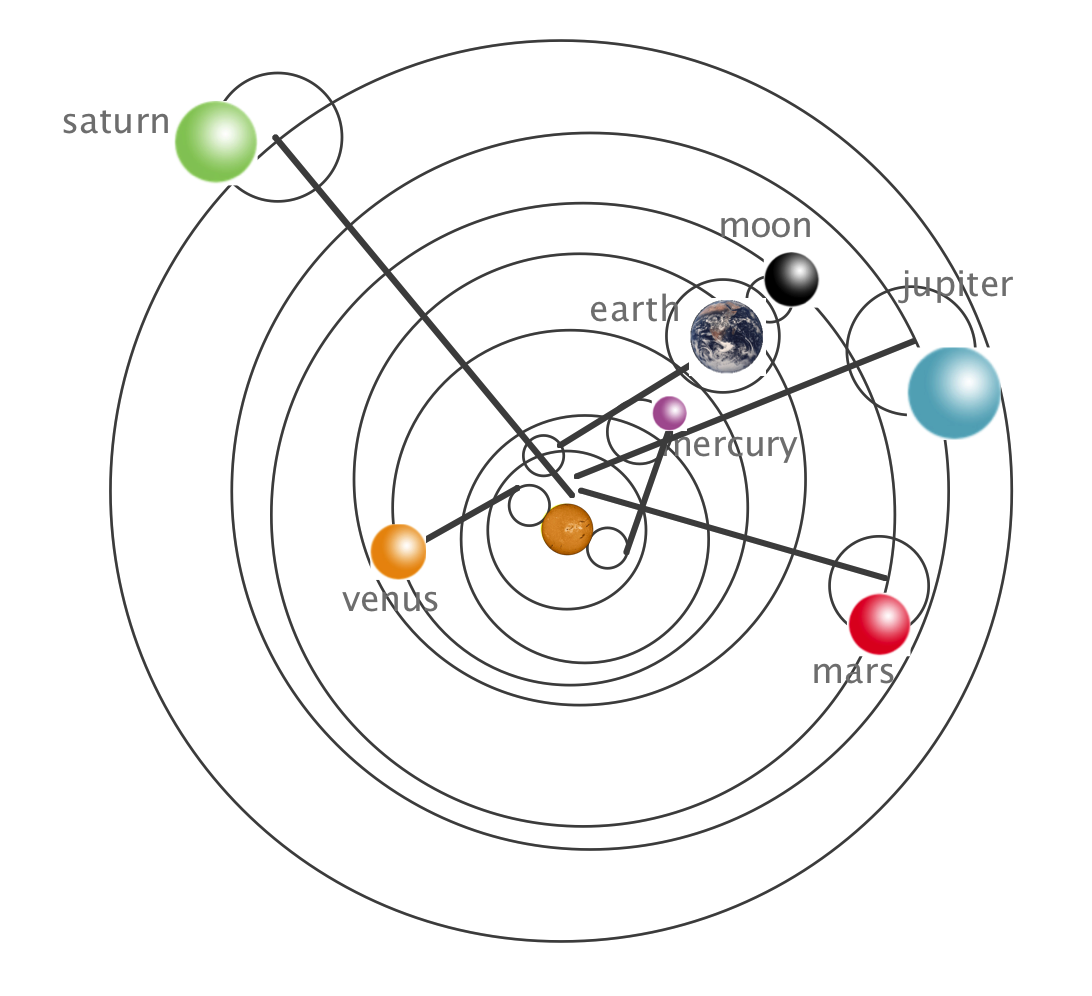9.5. Revolutionibus and Scandal#
9.5.1. The Copernican System#
In school you probably learned of the Copernican system of the planets. The Sun in the center of the solar system and the planets all orbiting in perfectly circular orbits. The right-hand figure above is familiar and indeed an image from Revolutionibus. In it, he criticizes the Ptolemaic system as a Frankenstein monster of sorts:
“…the true symmetry of its parts…they have been like someone attempting a portrait by assembling hands, feet, a head and other parts from different sources. These several bits may be well depicted, but they do not fit together to make up a single body. Bearing no genuine relationship to each other, these fragments, joined together, produce a monster rather than a man.” To him, there was no alternative than to order the planets according to the length of their years. “Thus we discover in this orderly arrangement the marvelous symmetry of the universe and a firm harmonious connection between the motion and the size of the spheres….”
Finally, the Sun, rather than just another orbiting bit takes on a central role:
“Behold, in the middle of the universe resides the Sun. For who, in this most beautiful Temple, would set this lamp in another or a better place, whence to illumine all things at once? For aptly indeed do some call him the lantern – and others the visible god, and Sophocles’ Electra, the Watcher of all things. Truly indeed does the Sun, as if seated upon a royal throne, govern his family of planets as they circle about him.”
Circles. Always circles.
Wait. We all learned that the orbits of the planets are not perfect circles, but the orbits are elliptical in shape. How did Copernicus get away with circles?
Glad you asked. He couldn’t! In fact, he required the use of epicyles as well as Ptolemy. His were not around deferents that went around the Earth, but rather the Sun. But clearly, he could not make circles work by themselves.
Pens out!
But Copernicus needed help with his circles and that came in the form of as many epicycles as Ptolemy!
Was Copernicus afraid of the Church? Not really. Remember, he had supporters and he was respected in the Vatican. He dedicated Revolutionibus to Pope Paul III! Things got bad for Copernicus’ work long after he had left the scene…and after the Vatican home-office decided to reboot and reassert its dominance in opposition to Protestantism and the general corruption of its far-flung clerical satellite offices.

When he finished the work, his assistant had to leave to go back to his home university. He took the manuscript with him, intending to drop it off at the publisher in Nürnberg, but left oversight with another Lutheran minister, Andreas Osiander, a dabbler in mathematics and familiar with this kind of publishing.
Protestant Osiander had been in communication with Copernicus and urged him to not state that the world was the way he presented it, but that his work was just a hypothesis. Catholic Copernicus ignored that advice. But Osiander did Copernicus a dirty trick. He added a preface of his own construction, which was a scandal:
“Since [the astronomer] cannot in any way attain true causes, he will adopt whatever suppositions enable the motions to be calculated…. For hypotheses need not be true nor even probable. On the contrary, if they provide calculations consistent with the observations, that alone is enough…. Different hypotheses are sometimes offered for one and the same motion (for example, either an eccentric or an epicycle model will explain the Sun’s motion). The astronomer will adopt whichever hypothesis is easier to grasp…. So as far as hypotheses are concerned, let no one expect anything certain from astronomy… lest he accept as truth ideas conceived for another purpose, and depart from this study a greater fool than when he entered it.”
Copernicus surely didn’t know that this had been added to his book as he’d suffered a debilitating stroke and died at the age of 70 on May 24, 1543. The touching legend is that he was presented with the published version on his deathbed, but that’s unsubstantiated.
Where he was buried was a mystery until 2008 when archaeologists found a skeleton under the Frombork Cathedral floor. DNA from grave matched DNA from hair found in a book that Copernicus owned. He was given another funeral in 2010 in the Cathedral, where his grave is now adorned with a handsome replica of the idealized Solar System as we know it today.
Copernicus came along at the right time and in the right place to re-imagine the planets in orbit around the Sun. His arguments were not driven by data – his model wasn’t more accurate than Ptolemy’s. Rather his argument was basically one of symmetry and philosophy. He thought that Ptolemy had described an ugly circumstance and could not explain the order of the planets.
The planets of our solar system orbit the sun.
Please answer Question 5 for points:
You might benefit from 6.1_cosmology2_copernicus_v1_.mp4 review and wrap-up of these sections.